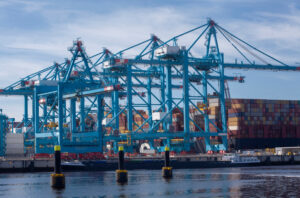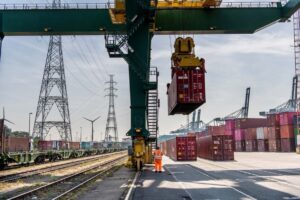VAHLE, an electrification systems specialist, has revealed details about its project with the largest container port in Thailand, Laem Chabang, operated by Hutchison.
The port has installed a 2+2 VAHLE electrification system for ten new rubber tyred gantry (RTG) cranes at the 6.5 million TEU capacity facility as part of its larger automation strategy.
But this stage of the Thai port's automation is a small part of a large and sustainable order for VAHLE as by the time the work is completed in 2020, the company will have electrified 17 large ship-to-shore cranes and 43 RTGs.
For the latest stage of the project, VAHLE has installed eight of the RTGs with a single telescopic arm and the remaining two with two arms.
A control software developed by VAHLE will enable the cranes to automatically use the system to couple and uncouple without the need for manual intervention.
VAHLE has also integrated components in the 'e-house' of the RTG – the result of a successful collaboration with crane manufacturer ZPMC in Shanghaia.
In a statement about the project, VAHLE said: “Ships are charged harbour dues by the hour.
“For this reason, the quick and reliable transport of containers to and from the ships is a top priority of the Hong Kong-based harbour operator company Hutchinson.
“Because the RTG cranes used for handling the containers usually travel along the same paths repeatedly, it is useful to install a conductor system and retrofit the cranes with electric drives.”
“This is what is happening on the 76-hectare port facility at Laem Chabang in three stages.”
Situated 25 kilometres north of the popular resort town of Pattaya on the shores of the Gulf of Thailand, Laem Chabang is the country's largest and most popular port
View automated solutions from VAHLE
For the power supply of the automation project, almost 2.5 kilometres of the 4-pole VAHLE U35 conductor system was installed with an additional 2.5 kilometres of SMGX data communication in a total of five double aisles.
VAHLE has ensured that environmental conditions like dust, humidity or temperature do not affect the systems.
Wireless communication within the port is also not an issue when it comes to transmission.
This fulfils the prerequisites for complete automation.
Read VAHLE's technical paper 'Electrifying RTGs: Improving Productivity and Savings' by Dr Lawrence Henesey
According to VAHLE, Laem Chabang will be the first port in the world with remote controlled cranes.
From an office several hundred metres away, an operator can use a joystick-style device to control up to three cranes simultaneously at a data transmission rate of up to 100 Mbit/s.
The system features an emergency stop signal and cranes can be monitored at all times by using video signals.
Joystick commands are only necessary for gripping the container.
VAHLE added: “Retrofitting with E-RTGs has a number of financial and environmental benefits.
“The cranes are low-maintenance and fuel consumption as well as CO2 emissions are almost zero.
“The cranes, which traditionally run on diesel fuel, are also equipped with an electric motor, similar to a hybrid car.
“95% of the time, the cranes run on electricity only which also reduces noise in the port.
“This is particularly important for ports that are close to residential areas, such as in Oslo, another port where VAHLE has retrofitted the cranes with electric drives.”










